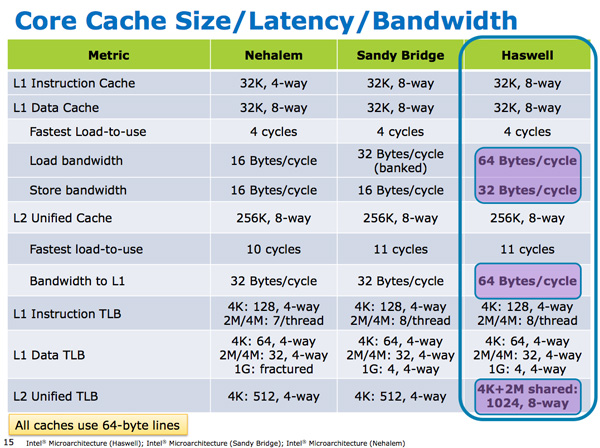Intel's Haswell Architecture Analyzed: Building a New PC and a New Intel
by Anand Lal Shimpi on October 5, 2012 2:45 AM ESTFeeding the Beast: 2x Cache Bandwidth in Haswell
With an outright doubling of peak FP throughput in Haswell, Intel had to ensure that the execution units had ample bandwidth to the caches to sustain performance. As a result L1 bandwidth is doubled, as is the interface between the L1 and L2 caches.
L1/L2 cache latencies and sizes remain unchanged. The same isn't true for the L3 cache however.











245 Comments
View All Comments
TeXWiller - Friday, October 5, 2012 - link
Perhaps they also try to reach lower usable clock frequencies through performance upgrades and this way gain some additional voltage scaling, or what is left of it.vegemeister - Saturday, October 6, 2012 - link
>think loop counters which store an INT for loop iteration then perform some FP calcsIf updating the loop counter us taking a substantial fraction of the CPU time, doesn't that mean the compiler should have unrolled more?
Anand Lal Shimpi - Friday, October 5, 2012 - link
The high end desktop space was abandoned quite a while ago. The LGA-2011/Extreme platform remains as a way to somewhat address the market, but I think in reality many of those users simply shifted their sights downward with regards to TDPs. A good friend of mine actually opted for an S-series Ivy Bridge part when building his gaming mini-ITX PC because he wanted a cooler running system in addition to great performance.To specifically answer your question though - the common thread since Conroe/Merom was this belief that designing for power efficiency actually means designing for performance. All architectures since Merom have really been mobile focused, with versions built for the desktop. I like to think that desktop performance has continued to progress at a reasonable rate despite that, pretty much for the reason I just outlined.
Take care,
Anand
csroc - Friday, October 5, 2012 - link
Sandy Bridge E just seems to price itself out of being reasonable for a lot of people. The boards in particular are rather steep as well.dishayu - Friday, October 5, 2012 - link
Well, LGA2011 is bit of a halo product with no real substance. An ivy bridge 3770K will stand up to a quad core LGA2011 part nicely, not to mention it supports PCI e gen3, so even though it has lesser lanes, it doesn't have a bandwidth disadvantage. Moreover LGA2011 is still stuck at sandy based architecture, so that again isn't quite on the bleeding edge and as far as i understand, Haswell will come out before IB-E does, so it's 2 full cycles behind.Kevin G - Friday, October 5, 2012 - link
For a single discrete GPU, Ivy Bridge would be able to match the bandwidth of Sandy Bridge-E: a single 16 lane PCI-E 3.0 connection. Things get interesting when you scale the number of GPU's. There is a small but clear advantage to Sandy Bridge-E in a four GPU configuration. Ivy Bridge having fewer lanes does make a difference in such high end scenarios.For its target market (mobile, low end desktop), Ivy Bridge is 'good enough'.
vegemeister - Saturday, October 6, 2012 - link
Quad core LGA2011 is kind of a waste though. If you're already paying extra for the socket, my philosophy is go hexcore and 8 DIMMs or go home.Peanutsrevenge - Friday, October 5, 2012 - link
Given that desktop software's not really been pushing for better CPU performance, the direction intel has taken is not a bad one IMO either.It's now possible to build a mighty gaming rig in an mITX case (Bit Fenix Prodigy), think 3770K and GTX 690 gfx and watercooled.
A rig like that will likely last 3 years before settings have to be tweaked to keep 60+ fps.
What's really needed is for software to take advantage of GPUs more, (which would play into AMDs hands), but I fear many of the best coders have switched from windows to Android/iOS development, With windows 8 shipping shortly, that number will increase further.
j_newbie - Saturday, October 6, 2012 - link
I think that is quite sad.I for one always need more FLOPS, MCAD work and simulation work depends on two things memory bandwidth+size and flops, surprisingly AMD still offers a better vfm deal in this space thanks to avx instructions not being widely adopted into most FEA/CFD code yet and the additional ram slots you get with cheaper boards.
Server components are always overpriced as we dont need a system to last very long.
my 3930k setup is about 1.5 times faster than the x6 setup at 3 times the cost... :(
Peanutsrevenge - Saturday, October 6, 2012 - link
You're talking more of a workstation than a desktop. Hence my use of the word 'desktop'.